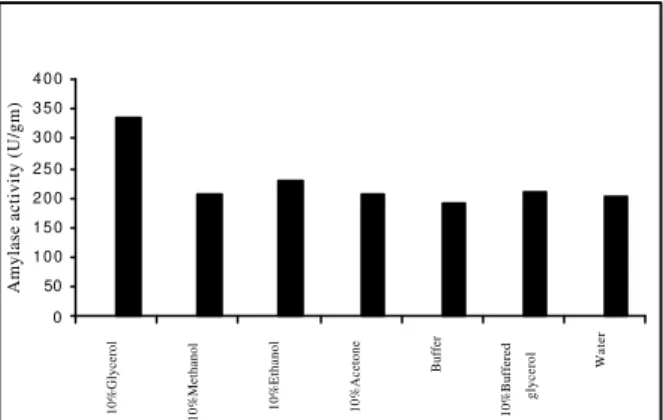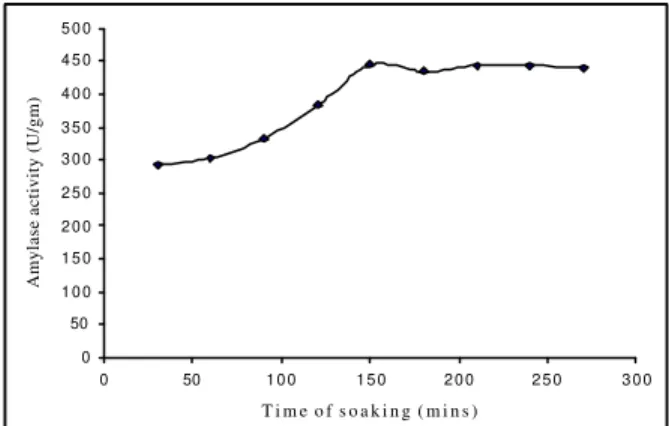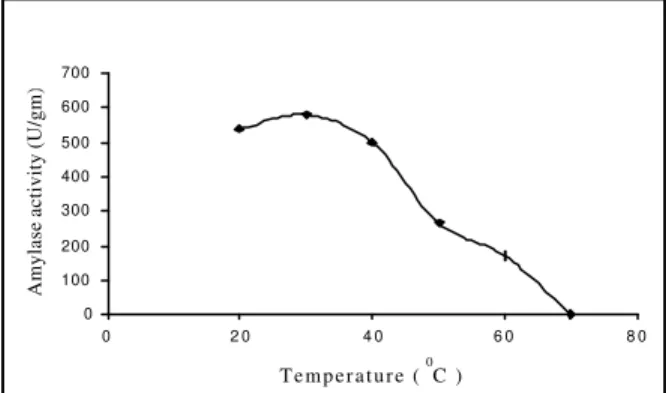Vol. 44, N. 1 : pp. 107 - 111, March, 2001
ISSN 1516-8913 Printed in Brazil
BRAZILIAN ARCHIVES OF
BIOLOGY AND TECHNOLOGY
A N I N T E R N A T I O N A L J O U R N A L
Optimization of Extraction Parameters for Recovery of
α
α
-amylase from the Fermented Bran of
Bacillus circulans
GRS313
Soumen Palit and Rintu Banerjee
*Microbial Biotechnology and Down stream processing laboratory, Department of Agricultural and Food Engineering; Indian Institute of Technology, Kharagpur-721302, West Bengal, India
ABSTRACT
The extraction of α- amylase in the solid state fermentation of wheat bran by Bacillus circulans GRS313 was optimized.
Among various solvents tested, maximum extraction was achieved when 2.5% (v/v) glycerol was added. The optimum
conditions for extraction were 2.5 hrs soaking time at 30° C under recirculation and agitated condition, which yielded
590 U/g bran of enzyme activity. Whereas under stationary soaking condition the activity of the enzyme was 439.58U/g bran. With repeated wash under the above optimum conditions showed that 600 U/g and 184.2 U/g of enzyme extracted in the 1st and 2nd washes respectively and only 36.84 U/g was recovered in the 3rd wash
Key words: Bacillus circulans; Solid state fermentation; α - amylase:Extraction
* Author for correspondence
INTRODUCTION
α-Amylases are responsible for hydrolysis of α-1, -4-glucosidic bonds in amylose, amylopectin and glycogen in endo-fashion. α-Amylases are mostly employed in pharmaceutical, textile, baking, brewing, paper coating, starch and syrup industries. α-Amylases are also used as digestive aid, detergents and for sewage treatment. There are reports of production of this enzyme from bacteria using solid state fermentation (Lonsane &Ramesh, 1990; Ramesh &Lonsane, 1988;Ramesh &Lonsane, 1987). In solid state fermentation the products are formed at or near the surfaces of the solid materials with low moisture content (Selvakumar & Pandey, 1999). So it is necessary to select a solvent for leaching out the product from the fermented mass. Depending upon its
application on process economics and to reduce further downstream processing costs, various techniques have been developed by the researchers (Castillo et al 1985; Bjusrstorm, 1985; Caltron, Coobs & Hmman, 1986).
To isolate the required product from the fermented biomass the report on solid state fermentation of
α-amylase production from Bacillus circulans is very much limited. The present communication deals with the efficiency of leaching of the enzyme amylase from the fermented biomass using the same strain.
MATERIALS AND METHODS
of IIT Kharagpur. It was routinely maintained at 4 0
C on 1% (w/v) nutrient agar slants.
Method of fermentation: The fermentation was carried out in 250ml Erlenmeyer flasks containing 10g of wheat bran, 0.05% (w/w) urea, .25% (w/w) MgCl2, .25% (w/w) KCl, ribose 1% (w/w), 25ml deionized water which was autoclaved for 20 mins at 121 0C. A cell suspension of 1% (v/w bran) containing 3×109 viable cells/ml was used as inoculum. Incubation was carried out for 60 hrs at 4 0 °C and 95% RH.
Extraction process
:
Extraction was conductedusing 10g fermented mass in 250ml conical flask. Extraction was done by soaking the fermented solid with a suitable solvent for a desired period .The crude extract was then squeezed out through a cotton cloth. The clear extract obtained after centrifugation to remove insolubles, assayed for amylolytic activity. The parameters selected for this study were type of solvent, volume of solvent, soaking time, physical state of leaching, soaking temperature and number of washes. The optimized values were repeated thrice in order to corroborate their validity.
Enzyme assay
:
The enzyme activity was assayedfollowing the method of Bernfeld (Bernfeld, 1955) using 3,5-dinitrosalicylic acid. The absorbance was measured at 540 nm. One unit of enzyme activity was defined as the amount of enzyme that release 1µmole of reducing sugar as glucose per minute under the assay condition specified.
RESULTS AND DISCUSSION
Solvent Selection:The extraction efficiency is
critical to the recovery of the enzyme from the fermented biomass, hence selection of a suitable solvent is necessary. Different solvents selected for this study were water, .1M acetate buffer pH 4.5, 10% (v/v) aqueous mixture of glycerol, 10% (v/v) aqueous mixture of ethanol, 10% (v/v) aqueous mixture of methanol, 10%, (v/v) aqueous mixture of acetone, 10% (v/v) glycerol prepared in .1(M) acetate buffer of pH 4.5. From fig (1) it is clear that among all the solvents used 10% (v/v) aqueous mixture of glycerol gave the best result.
0 50 1 0 0 1 5 0 2 0 0 2 5 0 3 0 0 3 5 0 4 0 0
10%Glycerol
10%Methanol 10%Ethanol 10%Acetone
Buffer
10%Buffered
glycerol
Water
Amylase activity (U/gm)
Figure 1 - Selection of solvent for Amylase extraction
Which indicate that organic solvents are more effective as soaking solvents than the inorganic ones, the reason can be explained by Debye-Hickel theory (Maron &Prutton eds 1965)
F = I/D/(Q1 Q2)/r 2
Where F= force of attraction or repulsion, D =dielectric constant, Q1, Q2 = charges of the attracting molecules, r = distance of two attracting molecules. All solvents have its own dielectric constant, organic solvents posses lower dielectric constantthan inorganic solvents, so water possesses higher dielectric constant than organic solvents, therefore from the above theory it can be concluded that force of interaction between amylase and solvent may have increased due to lowered dielectric constant of the extracting solvent, glycerol. Though other organic solvent posses lower dielectric constant than glycerol they may have some inhibitory effect on enzyme activity
0 5 0 100 150 200 250 300 350 400 450 500
0 2 4 6 8 1 0 1 2
Glycerol concentration (%)
Amylase activity (U/gm)
Figure 2 - Effect of glycerol concentration on Amylase
extraction process
Solid to Solvent Ratio
: In SSF system freeflowing solvent is very much limited. Thus adequate amount of solvent is required to leach out the enzyme present.
0 50 100 150 200 250 300 350 400 450 500
1:01 1:02 1:03 1:04 1:05 1:06 1:07
Solid to solvent volume
Amylase activity (U/gm)
Figure 3 - Effect of solvent volume on amylase
extraction.
The volume of the solvent i.e. 2.5% glycerol mixture was varied from 10ml to 70ml and extraction was done after 3 hrs of soaking. It was found that Fig (3) 30ml solvent in 10g of fermented bran, i.e. solid to solvent ratio of 1:3 was optimum. It was observed that total activity remains constant even though the solvent volume was increased by many folds, but there was a decrease in total activity when lower volume of solvent was used for extraction. This might be due to insufficient solvent volume to penetrate the solid fermented mass.
0 50 1 0 0 1 5 0 2 0 0 2 5 0 3 0 0 3 5 0 4 0 0 4 5 0 5 0 0
0 50 1 0 0 1 5 0 2 0 0 2 5 0 3 0 0
T i m e o f s o a k i n g ( m i n s )
Amylase activity (U/gm)
Figure 4 - Effect of incubation time on soaking.
Incubation time for soaking
:
Keeping thesolvent concentration and its volume at optimum level, incubation time for soaking was optimized for maximum enzyme recovery from the fermented bran. The time period was varied from 30 min to 270 min as shown in Fig (4). It was found that 150 min soaking was optimum and beyond that it did not have any additional effect on amylase extraction indicating the minimum time for the total penetration of solvent through the fermented biomass.
Physical state of leaching
:
Three differentleaching conditions were studied viz.stationary, agitation and recirculation. The results show that Fig (5) both agitation and recirculation conditions were effective for the leaching process.
0 100 200 300 400 500 600 700
Stationary Agitation Recirculation
Different leaching conditions
Amylase activity (U/gm)
Figure 5 - Effect of different leaching conditions on
amylase extraction.
&Bhattarcharya, 1999). During recirculation an additional drag force was added by the peristaltic pump, which facilitated the extraction process, by isolating maximum amount of amylolytic enzyme.
Effect of temperature on leaching process
:To study the effect of temperature on the leaching process the temperature was varied from 20 0C to 70 0C each at 10 0C intervals. It was observed that 30 0C was the most effective condition for leaching of the enzyme Fig (6), but at the higher temperature the yield was less. This might be due to the denaturation of the enzyme.
0 100 200 300 400 500 600 700
0 2 0 4 0 6 0 8 0
T e m p e r a t u r e ( 0C )
Amylase activity (U/gm)
Figure 6 - Effect of temperature on leaching.
Number of wash: The above parameter was optimized by adding a fresh aqueous mixture of 2.5% glycerol after the extraction for each wash. It was observed that out of three washes the first two were sufficient for maximum leaching of the enzyme. As expected, the first wash was more effective Fig (7).
0 1 0 0 2 0 0 3 0 0 4 0 0 5 0 0 6 0 0 7 0 0
F i r s t W a s h S e c o n d W a s h T h i r d W a s h
N u m b e r o f w a s h e s
Amylase activity (U/gm)
Figure 7 - Effect of number of washes on Amylase
extraction
The subsequent washes did not have significant effect on extraction.
RESUMO
Otimizou-se a extração de α- amilase na fermentação no estado sólido do farelo de trigo
Bacillus circulans GRS313 . Entre vários
solventes testados, conseguiu-se a melhor extração com solução 2,5% (v/v) de glicerol. As condições ótimas de extração foram de 2,5 horas de tempo de contato a 30° C sob condições de agitação e recirculação, chegando a uma atividade enzimática de 590 U/g farelo, enquanto chegou-se a uma atividade enzimática de 439.58U/g farelo sob condições de contato estacionárias. Com lavagens repetidas nas condições ótimas descritas acima, chegou-se à uma atividade enzimática de 600 U/g farelo e 184,2 U/g de enzima extraída nas 1 ª e 2ª lavagens, respectivamente, e apenas 36,84 U/g recuperada na 3 ª lavagem.
REFERENCES
Bjusrstorm, EE. (1985), Biotechnology Fermentation and Down stream processing, Chem Engg, 92, 120-158.
Bernfeld, P. (1955), Amylase α/β, Methods Enzymol 1, 149
Baily, J.E,Ollis,D.E.(eds). (1986), Biochemical
Engineering Fundamentals, McGraw Hill New York
Castillo, L.R, Alves, L.M Tito, Medronho, A. Ricardo. (1999), Recovery of Pectolytic enzymes producd by Solid State culture of Aspergillus niger, Process
Biochemistry, 34, 181-186
Caltron, G.J, Coobs, C.S, Hmman, J.P. (1986), Manual
of Industrial Microbiology and Biotechnology,
American society of microbiology Washington. U.S.A, 436-445
Losane, B. K. & Ramesh, M. V. (1990), Production of bacterial thermostable α-amylase by SSF. A potential tool for achieveing economy in enzyme production and starch hydrolysis, Av. Appl. Microbiol, 35,1-56 Maron, S. H, Prutton C. F. (Eds). (1965), Principles of
physical chemistry, Oxford and IBH publishing Co.
Pvt. Ltd., New Delhi (4th edition)
Ramesh, M.V.&Lonsane, B.K. (1987), Solid state fermentation for production of α-amylase by Bacillus
megaterium 16M,Biotechnol. Lett,9, 323-8
Ramesh, M.V.&Lonsane B.K. (1988), Factors effecting recovery of thermostable α-amylase from bacterial bran produced under SSF,Chem.Mikrobial Technol.
Lebensm, 11, 155-9
Selvakumar, P, Pandey, A. (1999), Solid State fermentation for the synthesis of inulinase from
Staphylo coccus sp and Kluyveromyces marxiams,
Stryer,L.(1975). Biochemistry, W.H Freeman and company NewYork; second Edition
Tunga, R, Banerjee, R, Bhattacharya, BC. (1999), Some studies on optimization of extraction process for protease for production in S.S.F, Bioprocess
Engineering, 20, 485-489.
Received: April 16, 1999; Revised: January 07, 2000; Accepted: May 30, 2000.


